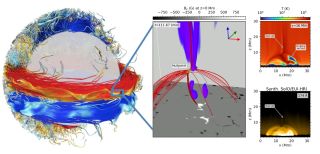Bibcode
Moreno-Insertis, F.; Nóbrega-Siverio, D.; Priest, E. R.; Hood, A. W.
Bibliographical reference
Astronomy and Astrophysics
Advertised on:
6
2022
Journal
Citations
1
Refereed citations
1
Description
Context. Ambipolar diffusion is a process occurring in partially ionised astrophysical systems that imparts a complicated mathematical and physical nature to Ohm's law. The numerical codes that solve the magnetohydrodynamic (MHD) equations have to be able to deal with the singularities that are naturally created in the system by the ambipolar diffusion term.
Aims: The global aim is to calculate a set of theoretical self-similar solutions to the nonlinear diffusion equation with cylindrical symmetry that can be used as tests for MHD codes which include the ambipolar diffusion term.
Methods: First, following the general methods developed in the applied mathematics literature, we obtained the theoretical solutions as eigenfunctions of a nonlinear ordinary differential equation. Phase-plane techniques were used to integrate through the singularities at the locations of the nulls, which correspond to infinitely sharp current sheets. In the second half of the paper, we consider the use of these solutions as tests for MHD codes. To that end, we used the Bifrost code, thereby testing the capabilities of these solutions as tests as well as (inversely) the accuracy of Bifrost's recently developed ambipolar diffusion module.
Results: The obtained solutions are shown to constitute a demanding, but nonetheless viable, test for MHD codes that incorporate ambipolar diffusion. Detailed tabulated runs of the solutions have been made available at a public repository. The Bifrost code is able to reproduce the theoretical solutions with sufficient accuracy up to very advanced diffusive times. Using the code, we also explored the asymptotic properties of our theoretical solutions in time when initially perturbed with either small or finite perturbations.
Conclusions: The functions obtained in this paper are relevant as physical solutions and also as tests for general MHD codes. They provide a more stringent and general test than the simple Zeldovich-Kompaneets-Barenblatt-Pattle solution.
Aims: The global aim is to calculate a set of theoretical self-similar solutions to the nonlinear diffusion equation with cylindrical symmetry that can be used as tests for MHD codes which include the ambipolar diffusion term.
Methods: First, following the general methods developed in the applied mathematics literature, we obtained the theoretical solutions as eigenfunctions of a nonlinear ordinary differential equation. Phase-plane techniques were used to integrate through the singularities at the locations of the nulls, which correspond to infinitely sharp current sheets. In the second half of the paper, we consider the use of these solutions as tests for MHD codes. To that end, we used the Bifrost code, thereby testing the capabilities of these solutions as tests as well as (inversely) the accuracy of Bifrost's recently developed ambipolar diffusion module.
Results: The obtained solutions are shown to constitute a demanding, but nonetheless viable, test for MHD codes that incorporate ambipolar diffusion. Detailed tabulated runs of the solutions have been made available at a public repository. The Bifrost code is able to reproduce the theoretical solutions with sufficient accuracy up to very advanced diffusive times. Using the code, we also explored the asymptotic properties of our theoretical solutions in time when initially perturbed with either small or finite perturbations.
Conclusions: The functions obtained in this paper are relevant as physical solutions and also as tests for general MHD codes. They provide a more stringent and general test than the simple Zeldovich-Kompaneets-Barenblatt-Pattle solution.
Movies associated to Figs. 4 and 7 are available at https://www.aanda.org
Related projects

The Whole Sun Project: Untangling the complex physical mechanisms behind our eruptive star and its twins
The Sun is a magnetically active star with violent eruptions that can hit Earth´s magnetosphere and cause important perturbations in our technology-dependent society. The objective of the Whole Sun project is to tackle in a coherent way for the first time key questions in Solar Physics that involve as a whole the solar interior and the atmosphere
Fernando
Moreno Insertis

Numerical Simulation of Astrophysical Processes
Numerical simulation through complex computer codes has been a fundamental tool in physics and technology research for decades. The rapid growth of computing capabilities, coupled with significant advances in numerical mathematics, has made this branch of research accessible to medium-sized research centers, bridging the gap between theoretical and
Daniel Elías
Nóbrega Siverio